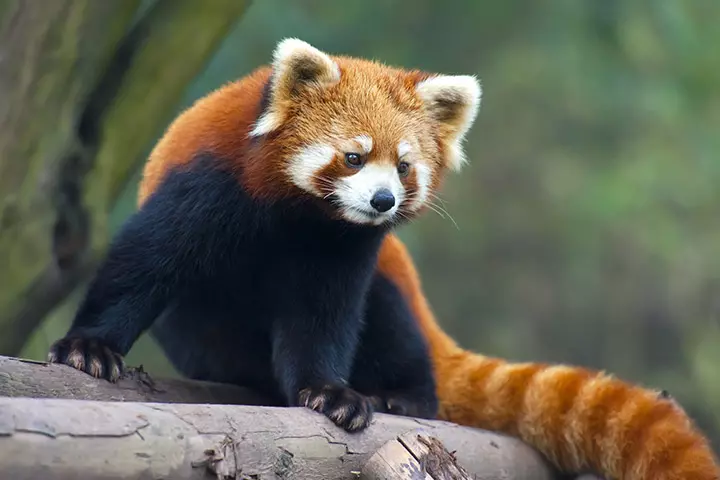
Image: ShutterStock
Red pandas are soft and cuddly mammals that look like teddy bears. They are gentle creatures that show friendly behavior and live high in the trees, feed on bamboo, and pretty much chill most of the time. In this post, we provide you with intriguing red panda facts for kids, including information on their lives, habitat, and food habits.

Unfortunately, the cute species has recently been threatened with extinction because of human encroachment on their habitat. Hence, we must educate our children about red pandas and prevent them from going extinct.
Key Pointers
- Red pandas belong to a unique biological family with no other living members.
- They can live up to 14 years in captivity, but the average lifespan is around eight years, while rare cases show they may live up to 23 years.
- Being nocturnal animals, they wrap their bushy tails around themselves to keep warm, and their long tails help them balance while walking on narrow branches.
- Female red pandas give birth to three to four cubs during spring and summer, with a gestation period of 130 days.
- Bamboo branches make up to 85% of their diet, and they also consume fruits, insects, small reptiles, and bird eggs.
Quick Facts About The Red Panda
Scientific name: Ailurus fulgens
Size: Body is 22 – 24.6 inches (56 – 62.5 centimeters) long. The tail is about 14.6 – 18.6 inches (37 to 47.2 centimeters)
Weight: Males, 8.8-13.3 pounds (4 – 6.5 kilograms); Females, 6.6-13.2 pounds (3-6 kilograms)
Lifespan: 8 years in the wild; Can reach 14 years of age in captivity
`
IUCN conservation status: Endangered
Name & Taxonomy

- The name panda comes from the Nepali word called “poonya,” which means bamboo eater.
- The red panda is not related to the giant panda but is more closely related to a raccoon.
- Before the discovery of the giant panda, the red panda was simply called panda. It was known to the Western world way before the black and white giant panda came into the limelight.
- Red pandas were once considered to be of the bear family. However, extensive DNA analysis found that they belong to a family of their own.
Christine Lucas, an animal lover, remarks how she was confused on her first live interaction with a red panda. She says, “It’s been eight years since I saw my first red panda, oblivious to their existence until then. For me, it was love at first sight! They seem to be a number of animals all rolled into one, which has caused countless debates as to what family or classification of animal the red panda truly is (i).”
- They are the only living members of their biological family called Ailuridae. All other members of the family are extinct.
- There are two subspecies of the red panda: fulgens and styani. Pandas of the styani subspecies are usually larger and with deeper fur color when compared to fulgens subspecies.
- Red panda goes by several other English names, the most popular ones being firefox, fire cat, and red cat. Some zoology researchers also refer to the animal as the ‘lesser panda’.
- They may sometimes be confused, from a distance, with a cat, as the size of the animal is quite similar to that of a domestic cat.
Lifespan

- The red panda has an average lifespan of eight years, although those living in captivity may live up to 14 years.
- In rare instances, captive red pandas may live up to 23 years.
Appearance

- The body of an adult panda (except the tail) usually stands at 22 – 24.6 inches (56 – 62.5 centimeters). Interestingly, their tail alone can measure at 14.6 – 18.6 inches (37 to 47.2 centimeters).
- The wrist bone extends to create a false thumb, which allows the animal to have an optimum grip. Red panda shares the extended wrist bone feature with the giant panda.
- The fur on the back and above the limbs is reddish brown. The fur on the limbs and belly is black. They have large, round faces with big eyes, giving them a bear-like appearance.
- An adult male red panda can weigh about 8.8-13.3 pounds (4 – 6.5 kilograms). Females weigh between 6.6-13.2 pounds (3-6 kilograms).
- Red pandas have furry feet. It helps them have a better grip when walking in snow.
- Cubs are covered with fur and are almost blind with their eyes closed at birth. A single cub weighs about 3 – 4 ounces (approx. 90 to 110 grams).
- They have sharp claws almost resembling that of a cat. The red panda’s claws help it grip the bark of the tree while climbing.
- Claws are semi-retractile, which means the animal can partially withdraw within the paw.
Habits & Lifestyle

- The red panda uses its tail to wrap itself when the weather is cold. The tail makes a great blanket when it is snowing. It explains why they have such long, bushy tails.
- The long tail of the animal also has another functional benefit: it helps the animal balance its weight when walking on narrow tree branches.
- They are mostly nocturnal. They may also forage for food during dusk and dawn.
- Red pandas show most activity during colder weather and tend to become lethargic when the weather gets warm.
- Red pandas spend the majority of their time on tree tops and thus are arboreal animals.
- The Red panda is mostly solitary except during mating season.
- It is less common to see red pandas live in pairs and rare to see them stay in family groups.
- It is a quiet animal and has very few vocalizations such as twitter and squeal. Sometimes they may hiss or grunt. Cubs whistle or bleat often to call their mother.
- Just like a dog, red pandas pant during warm weather to cool their bodies and regulate their body temperature.
- Male red pandas fight while standing on their hind legs and strike each other with their claws.
Reproduction

- Female red pandas have a gestation period of 130 days (about four months and ten days).
- Females give birth to three to four cubs during spring or summer.
- Red pandas do not stay in pairs, and only females raise the cubs.
- The female makes a nest in tree stumps, tree holes or bamboo thickets before giving birth to the cubs. Nests are usually lined with leaves or moss.
Diet

- The main food of the red panda is bamboo branches. It also eats fruit, insects, small reptiles, and even bird eggs.
- Bamboo makes 85-90% of a Red panda’s diet. They prefer the leaves and shoots of the plant.
- Although they spend most of the time on trees, they may descend to the ground to dig out roots and grass to eat when they are very hungry.
- A red panda is heavily dependent on its habitat for food and may not migrate to other areas to look for extra food, unlike other animals. It makes the animal very sensitive to any habitat destruction.
- Red pandas avoid water. They get most of their water intake from their solid diet.
Habitat & Endangerment

- A single red panda will command a forest area of one square mile, which is their territory.
- Red panda’s natural habitat spreads across five countries namely China, India, Nepal, Burma, and Bhutan.
- In their natural habitat, the top predator or threat to a red panda is the Snow leopard.
- Red pandas prefer colder climates and do not like temperatures above 25°C (77°F).
- At any sign of danger, the red panda will scurry up the nearest tree. If cornered, a red panda will stand on its hind legs and defend itself with its sharp paws and teeth.
- Less than 10,000 red pandas are left in the wild, and their numbers are slowly declining.
- The red panda is at risk of poaching and losing its habitat due to deforestation. The International Union for Conservation of Nature (IUCN) declared the red panda as an endangered animal in the year 2008.
- About 70% of red panda habitat falls outside government-protected areas, which makes conservation of the animal even more essential.
- Red pandas that live in captivity undergo some basic training to help them interact with human beings. However, if they show no interest in training, then the panda is not trained forcefully.
Red Panda In Society & Culture

- A company called Mozilla chose the red panda as the software icon for its internet browser called Firefox, which is another name for the Red panda.
- In the popular animated film Kung Fu Panda, the character of Shifu, who is the Kung Fu teacher, is a Red panda.
- Every year, the Indian state of Sikkim organizes a music event called the Red Panda Festival. The red panda is the state animal of Sikkim.
- Every year, the international community of conservationists picks a date in September as International Red Panda Day. Various zoos and natural history organizations conduct conservation programs with conservation efforts in mind on this day to spread awareness about red panda conservation.
- Although pandas are perceived as gentle and cute animals, the red panda cannot be domesticated. These pandas are wild animals and under no circumstance can they become pets.
Frequently Asked Questions
1. What are baby red pandas called?
Baby red pandas are called cubs, just like the offsprings of their black-and-white namesake, the giant panda.
2. How long do red pandas sleep?
Red pandas sleep for long hours during the day, usually perched in a tree with their bushy tail wrapped around them for warmth. They are usually solitary creatures and become active at night.
3. Do red pandas cry?
A red panda has a distinctive cry because of which it is also known as Wah (4). However, these animals are generally quiet. They mostly tweet and whistle to communicate.
4. Do red pandas glow in the dark?
Red pandas do not glow in the dark in the usual sense of the word. But the white areas on their faces appear to be luminescent. So, when it’s dark, this characteristic can guide lost cubs back to their mothers (5).
5. Do red pandas get angry?
Aggression is not a typical trait of red pandas. But when they do, they arch their backs and tails. They also shake their head sideways, stand on their hind legs, and bat at their opponents with paws (6).
6. Do red pandas swim?
Yes, red pandas are exceptional swimmers, but they seldom engage in this activity (4).
7. What is a group of red pandas called?
A group of red pandas is called a pack, but they are mostly seen alone except during mating season.
Red pandas are fluffy, cuddly animals that look like teddy bears and live high up in the trees. They are presently listed as an endangered species since humans have destroyed their natural habitat. Therefore, provide all-round education to your children with some fascinating red panda animal facts and inspire them to contribute toward protecting these animals from extinction. If your child has an affinity for learning about nature and different animals, they will surely be amused by this peculiar creature and these interesting facts about its lifestyle, appearance, and more. As you tell them these facts, you may also engage them with some fun kung fu panda coloring pages.
Infographic: Protecting The Red Panda
The red panda species have become endangered due to various human activities; however, protecting them from extinction is important to maintain a balance of flora and fauna on the planet. This infographic highlights the reasons for protecting the red panda, things you can do, and steps a few organizations are taking in this direction. Illustration: Momjunction Design Team
Illustration: Amazing And Interesting Red Panda Facts For Kids

Image: Stable Diffusion/MomJunction Design Team
Personal Experience: Source
MomJunction articles include first-hand experiences to provide you with better insights through real-life narratives. Here are the sources of personal accounts referenced in this article.
i. My love for the red panda.https://redpanda08.wordpress.com/2016/09/06/my-love-for-the-red-panda/
References
- Yibo Hu et al.; (2025); Genomic evidence for two phylogenetic species and long-term population bottlenecks in red pandas; Science Advances.
https://www.science.org/doi/10.1126/sciadv.aax5751 - Red Panda; Smithsonian’s National Zoo & Conservation Biology Institute.
https://nationalzoo.si.edu/animals/red-panda - Red Panda; San Diego Zoo Wildlife Alliance.
https://animals.sandiegozoo.org/animals/red-panda - Red Panda; Animalcorner.org
https://animalcorner.org/animals/red-panda/ - 15 fantastic facts about red pandas; redpandanetwork.org
https://redpandanetwork.org/post/15-Fantastic-Facts-about-Red-Pandas#:~:text=Red%20Pandas%20Glow%20in%20the - Red Panda; Brandywinezoo.org
https://brandywinezoo.org/animals/red-panda/#:~:text=Aggression%20is%20rare%2C%20but%20angry - How to care for red pandas; Smithsonian’s Nationa Zoo and Conservation Biology Institute
https://nationalzoo.si.edu/animals/news/how-care-for-red-pandas#:~:text=Although%20red%20pandas%20are%20excellent
Community Experiences
Join the conversation and become a part of our nurturing community! Share your stories, experiences, and insights to connect with fellow parents.
Read full bio of Dr Rebbecca Wilcox
Read full bio of Sravani Rebbapragada
Read full bio of Harshita Makvana
Read full bio of Praggya Joshi


















